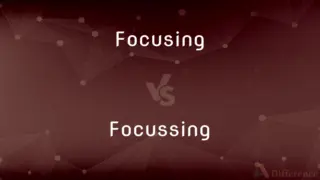Figurehead vs. Leadership — What's the Difference?
By Fiza Rafique & Maham Liaqat — Updated on April 1, 2024
Figureheads symbolize authority without wielding actual power, whereas leadership involves guiding and influencing others with real authority.

Difference Between Figurehead and Leadership
Table of Contents
ADVERTISEMENT
Key Differences
Figureheads are often symbolic leaders with no real decision-making power, serving as a representation of an organization's values or history. In contrast, leadership embodies the act of guiding, directing, and influencing others towards achieving common goals. While figureheads may hold ceremonial roles or serve as the face of an organization, leaders are actively involved in strategizing, decision-making, and motivating their team.
Figureheads, such as constitutional monarchs, primarily perform ceremonial duties and have limited involvement in the day-to-day operations of an entity. Leadership, on the other hand, is fundamentally about influencing behavior and shaping organizational culture, requiring a hands-on approach to management and decision-making.
In terms of influence, figureheads typically exert soft power through their symbolic presence, which can unify or inspire pride among members of an organization or nation. Conversely, leadership wields hard power, including the ability to make significant changes, implement strategies, and directly affect outcomes and the organization's direction.
While figureheads may serve as a moral compass or a stabilizing figure during turbulent times, leadership is responsible for navigating the organization through challenges, making critical decisions, and ensuring operational continuity.
Figureheads are often chosen for their symbolic value or lineage, as seen in monarchies or ceremonial positions, where their role is largely predetermined. Leadership, however, is characterized by earned authority, often through demonstrated expertise, skills, and the ability to inspire and manage a team effectively.
ADVERTISEMENT
Comparison Chart
Power
Symbolic, no real decision-making authority
Real, involves decision-making and control
Role
Ceremonial, symbolic
Active, guiding, influencing
Influence Type
Soft power (inspiring, unifying)
Hard power (direct, strategic)
Selection Criteria
Symbolic value, lineage
Demonstrated skills, expertise
Main Function
Representation, embody values
Guide, direct, make strategic decisions
Compare with Definitions
Figurehead
Often associated with traditional roles or entities.
The figurehead at the ship's prow is a remnant of nautical tradition.
Leadership
Focuses on motivating and managing teams.
Her leadership is evident in how she inspires and manages her team.
Figurehead
A ceremonial leader without real power.
The queen serves as a figurehead, symbolizing the nation's heritage.
Leadership
The act of guiding and influencing others towards a goal.
Her leadership during the project led to its success.
Figurehead
Plays a role in public relations or ceremonial events.
The president served as a figurehead at the international conference.
Leadership
Can be found at various levels within an organization.
Leadership isn't just at the top; it's needed at all levels.
Figurehead
Symbolizes authority or represents an organization.
The company founder now acts as a figurehead, attending major events.
Leadership
Shapes the culture and direction of the organization.
His leadership transformed the company's approach to innovation.
Figurehead
Can unify or inspire pride through symbolism.
The monarch remains a figurehead, uniting the country in times of crisis.
Leadership
Involves decision-making and strategic planning.
Effective leadership requires making tough decisions for the team's benefit.
Figurehead
In politics, a figurehead is a person who de jure (in name or by law) appears to hold an important and often supremely powerful title or office, yet de facto (in reality) exercises little to no actual power. This usually means that they are head of state, but not head of government.
Leadership
Leadership is both a research area, and a practical skill encompassing the ability of an individual, group or organization to "lead", influence or guide other individuals, teams, or entire organizations. Often viewed as a contested term, specialist literature debates various viewpoints, contrasting Eastern and Western approaches to leadership, and also (within the West) North American versus European approaches.
Figurehead
A carved figure on the prow of a ship.
Leadership
The position or office of a leader
Ascended to the leadership of the party.
Figurehead
A person given a position of nominal leadership but having no actual authority.
Leadership
Capacity or ability to lead
Showed strong leadership during her first term in office.
Figurehead
(nautical) A carved figure on the prow of a sailing ship.
Leadership
A group of leaders
Met with the leadership of the nation's top unions.
Figurehead
(by extension) Someone in a nominal position of leadership who has no actual power; a front or front man.
Leadership
Guidance; direction
The business prospered under the leadership of the new president.
Figurehead
A person's face.
Leadership
The capacity of someone to lead others.
Figurehead
The figure, statue, or bust, on the prow of a ship.
Leadership
A group of leaders.
Figurehead
A person who allows his name to be used to give standing to enterprises in which he has no responsible interest or duties; a nominal, but not real, head or chief.
Leadership
The office or status of a leader.
Figurehead
A person used as a cover for some questionable activity
Leadership
The office, position or function of a leader; as, Gingrich held the House leadership for six years.
Figurehead
Figure on the bow of some sailing vessels
Leadership
The quality of character and personality giving a person the ability to gain the confidence of and lead others; as, Washington's leadership was indispensible to success of the American Revolution.
Leadership
The people who serve as leaders of a group; as, the party leadership was in disarray after the election.
Leadership
The activity of leading;
His leadership inspired the team
Leadership
The body of people who lead a group;
The national leadership adopted his plan
Leadership
The status of a leader;
They challenged his leadership of the union
Leadership
The ability to lead;
He believed that leadership can be taught
Common Curiosities
Can a leader be a figurehead?
Yes, in some contexts, leaders can also serve as figureheads, symbolizing the organization's values while actively guiding it.
How does leadership differ from being a figurehead?
Leadership involves active guidance, decision-making, and influence, whereas a figurehead serves a more symbolic, ceremonial role.
Why are figureheads important?
Figureheads play a crucial role in unifying and inspiring pride among members of an organization or nation through their symbolic presence.
What qualities make effective leadership?
Effective leadership requires skills such as decision-making, strategic planning, communication, and the ability to motivate and manage a team.
What is a figurehead?
A figurehead is a symbolic leader without actual decision-making power, representing an organization's values or history.
How do leaders influence their organizations?
Leaders influence their organizations by setting direction, making strategic decisions, and shaping organizational culture and policies.
Is leadership innate or learned?
While some leadership qualities may be innate, many aspects of leadership can be learned and developed over time.
Do figureheads have any real power?
Figureheads typically do not have real decision-making power but can influence through their symbolic role and soft power.
Can anyone become a leader?
With the right skills, mindset, and dedication, many individuals have the potential to become effective leaders.
How can someone develop leadership skills?
Leadership skills can be developed through experience, education, mentorship, and continuous learning and reflection.
How does leadership impact team performance?
Effective leadership positively impacts team performance by providing direction, motivation, and a clear vision, leading to better outcomes.
What role do figureheads play in society?
In society, figureheads can serve as moral compasses, symbols of unity, and representatives of cultural or national heritage.
Are figureheads always individuals?
While figureheads are often individuals, the term can also refer to entities or symbols that represent broader concepts or values.
What challenges do leaders face?
Leaders face challenges such as making difficult decisions, managing diverse teams, navigating change, and maintaining vision and direction under pressure.
How do figureheads and leaders influence public perception?
Both figureheads and leaders play significant roles in shaping public perception figureheads through symbolic representation and leaders through their actions and decisions.
Share Your Discovery

Previous Comparison
Frame vs. Skeleton
Next Comparison
Cyano vs. NitrileAuthor Spotlight
Written by
Fiza RafiqueFiza Rafique is a skilled content writer at AskDifference.com, where she meticulously refines and enhances written pieces. Drawing from her vast editorial expertise, Fiza ensures clarity, accuracy, and precision in every article. Passionate about language, she continually seeks to elevate the quality of content for readers worldwide.
Co-written by
Maham Liaqat












































